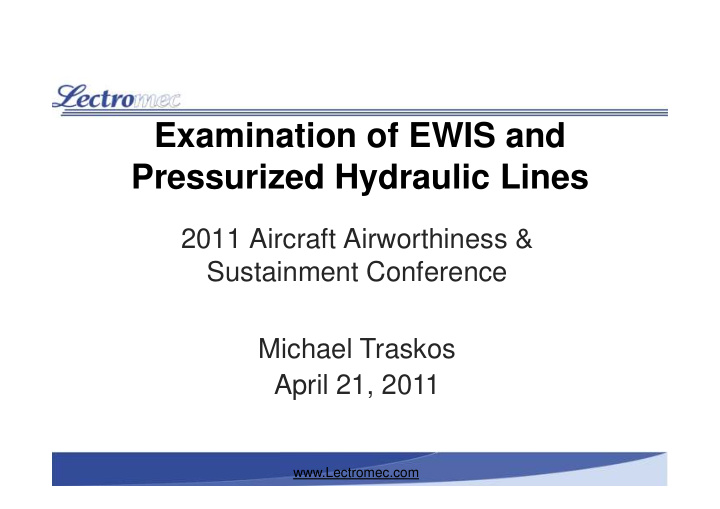



Examination of EWIS and Pressurized Hydraulic Lines 2011 Aircraft Airworthiness & Sustainment Conference Michael Traskos April 21, 2011 www.Lectromec.com
Examination of EWIS and Pressurized Hydraulic Lines • Research focused on arc damage at a distance to pressurized hydraulic lines • Goals: – Understanding the factors that affect separation requirements – Determine the level of damage that sustained by a pressurized hydraulic tube – Determine the yield temperature of aluminum under pressure. – Provide seed data for arc damage simulations. www.Lectromec.com
Background to Electrical Arcing • The damage caused by electrical arcing from wires has been well documented. • Chafing of a power wire against a grounded hydraulic line and the subsequent damage have previously been examined. • Limited research has been done on arc damage at a distance. • All arcing events generate localized hot, ionized gas. This ‘arc plume’ can cause damage to objects inches away from the arcing event. Example of arc damage • The ionized arc plume makes it possible for to unpressurized tube air to conduct electricity and therefore to arc directly from the power wire to a grounded target. www.Lectromec.com
Test Circuit • Power Source : 20kVA, 400Hz, 3 phase generator • Wire Configuration : 3 Wires (one floating, two on different phases) • Circuit Protection : No circuit protection except for a circuit control unit able to cut power to the system after a predetermined time. • Target : Aluminum Tube Alloy 6061 www.Lectromec.com
Test Configuration • Testing was performed with the wire bundles prepared in two different configurations • One set of tests were performed with a sliver cut • One set of tests were performed with a standard ring cut • Thermocouples were affixed to inside wall of tube facing arcing event.
Pressurized Tube Test Video www.Lectromec.com
Overhead View of Arcing Event • Camera placed over the experiment to monitor the direction of the arc plume • Experimentation has shown that the arc can vary more that 45 o from vertical for the same configuration • Image shows an example of the UV filtered arc plume www.Lectromec.com
Tube Breach Analysis • The tube rupture was 1mm x 1.5mm. • Noticeable pitting around the rupture location. Tube Breach • Thermocouple was 1cm away from the tube breach. Measured temperature was not at the center of arc. • Tube ruptured after arc had stopped .
Simulating Breach with ADMT • What is the Arc Damage Modeling Tool ? – Arc Damage Modeling Tool is a finite element tool based on the damage profiles, waveforms, and analysis on thousands of arc tests. – Originally developed with the FAA Tech Center – Capable of modeling damage from both direct contact and arcing at a distance www.Lectromec.com
Arc Damage Simulation Process • Some parameters (such as fluid-tube thermal transfer coefficient) had to be gathered through progressive updates to simulation parameters • Data was necessary to validate pressurized tube model Analyze Configure Simulation Perform ADMT Complete ADMT result vis-à- arc testing Simulation Model Parameters vis test data Update Parameters www.Lectromec.com
Comparison against ADMT Results • Simulation used arcing waveform from test as seed data • Temperature at center of arc area was approximately 235 o C. • Temperature does not match at 1s because ADMT does not yet model energy loss during breach. • Simulation results are close to temperature measurements. www.Lectromec.com
Simulation of Unbreached Tube • The arc plume did not fully consume the target tube. • The simulation showed excellent correlation with the laboratory results. www.Lectromec.com
Additional Considerations #1: These tests were done with the tube at room temperature. Operating temperatures are higher. Hydraulic lines are more susceptible to breach from arc events. #2: Tube material properties matter. Tubes made of material with lower thermal conductivity (e.g. Titanium) are more susceptible, because they cannot conduct the heat from arc event. www.Lectromec.com
Conclusion • The tube pressurization makes a significant difference in the amount of energy necessary to create a breach in the tube wall. • Even without direct contact, it is possible to transfer sufficient energy to cause a breach of a pressurized line. The effects of hydraulic fluids should be considered in any analysis to determine safe separation distances. • Simulations showed excellent alignment with the laboratory data and have been presented in this paper. Further testing is necessary to ensure validation of the simulation results. www.Lectromec.com
THANK YOU Michael Traskos Lectromec mtraskos@lectromec.com www.Lectromec.com
Recommend
More recommend